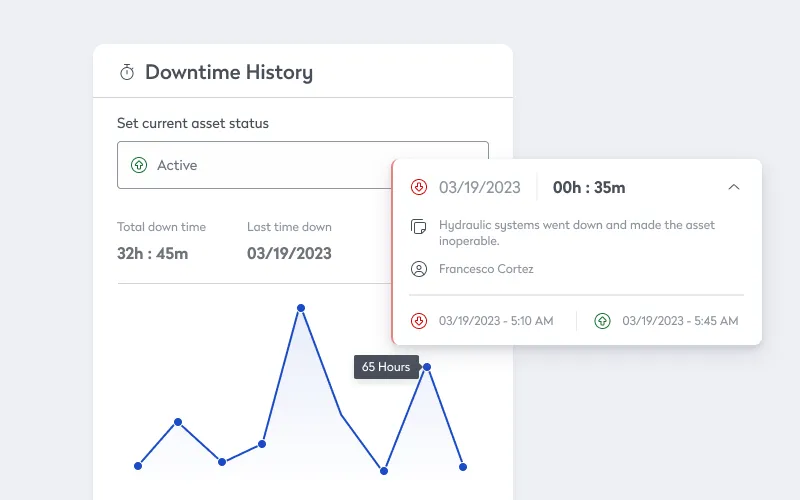
Facility and maintenance managers play a critical role in ensuring the efficient operation of healthcare facilities. From maintaining the physical infrastructure to managing equipment, the responsibilities are as vast and ever evolving as the field of medicine itself. Understanding the challenges and best practices in healthcare facilities management (HFM), including the increasingly important role of technology, can help you deliver an environment that is safe and supportive for both patients and staff.
What is healthcare facilities management?
Healthcare facilities management is the combination of people, programs, and processes that ensure the development, security, operations, and maintenance of facilities focused on healthcare services.
Why is healthcare facilities management important?
In this industry, facility and maintenance management decisions can mean the difference between life and death. And it’s not only when a high-tech piece of medical equipment suddenly stops working.
It can be something simple that quickly becomes critical, including:
- The automatic gate for the visitor parking lot jamming, and soon there’s a lineup of cars that stretches all the way across the entrance to the emergency room, blocking incoming ambulances.
- The elevators stop working, preventing nurses and orderlies from rushing a critical patient strapped to a gurney to an operating room three floors up.
- The handrail is loose. An elderly patient grabs it to steady themselves, it comes off the wall, and they fall and break a hip.
Health care maintenance is also important because of all the money involved. It can mean the difference between passing compliance audits and facing expensive fines. It can also mean the difference between quick, inexpensive fixes and costly, complicated repairs.
And the more money you spend on maintenance, the less there is to invest in other areas that directly benefit patients’ comfort and outcomes.
What are the types of healthcare facilities?
“Healthcare facility” is not just a fancy way of saying hospital or doctor’s office. There are many different types of facilities, each serving a different category of patient.
Ambulatory surgical centers
Streamlined versions of hospital surgical wards, these centers focus on a narrow band of surgical procedures. Advantages include lower costs and a lower risk of infection. Also sometimes called outpatient surgical facilities.
Birth centers
Cost-effective, family-inclusive birth environments. Because they don’t have the same equipment as hospitals, they work with pregnancies where there are no known complications.
Blood banks
Safe collection, sorting, and storage of donated blood and platelets. Because blood and blood products cannot be manufactured, these centers are critical for everyone from people with anemia to car crash victims.
Clinics and medical offices
Broad category covering everything from a general practitioner’s private practice to a dentist’s office, from specialists to walk-in clinics. The common denominator is that they work on an out-patient basis.
Diabetes education centers
Educational opportunities and support for those with or at risk of developing the disease. As the illness becomes more widespread, these centers are becoming more common.
Dialysis centers
Specialized care for patients with kidney disease, who sometimes require dialysis, blood filtering and cleaning, as many as three times a week.
Hospice homes
End-of-life care with a broad mandate to provide not only medical but also emotional care. Although some patients remain in their homes, those with significant needs are moved to hospice homes or specialized nursing homes.
Hospitals
Large health care facilities that offer a wide range of medical services, ranging from childbirth to intensive care units for patients with life-threatening injuries. Wards are generally divided between intensive and non-intensive care.
Imaging and radiology centers
Diagnostic imaging services including CT scans, ultrasounds, X-rays, and MRIs. Hospitals often have in-house centers, but outpatient facilities can provide lower costs and better scheduling.
Mental health and addiction treatment centers
Another broad category, but here includes everything from large facilities for many types of mental health care to specialized treatment facilities for specific addictions, including alcohol, illegal, and prescription drugs. Both in-patient and out-patient options exist.
Nursing homes
Positioned for patients with long-term medical needs that are not serious enough to require hospitalization but who cannot be cared for at home. In some cases, they’re very much like apartment complexes, but with full-time medical staff. Generally, for older patients, but some facilities cater to younger residents.
Urgent care centers
On-demand health care that falls between the need for a hospital and a doctor’s office. Often used by parents with sick children with everything from a bad flu to a broken arm.
What are health facilities management best practices?
Here are some concrete steps you can take to improve your hospital maintenance programs and processes.
Start at the end
According to American Hospital Association, hospitals and post-acute care providers must comply with 629 regulatory requirements across nine domains. And compliance takes a lot of time and money. According to the same report, across the industry, it costs health care providers $1,200 in compliance overhead every time a patient is admitted.
Whenever you look at your maintenance management policies and workflows, try to see them through the lens of compliance. Which assets need to be on the top of your list for inspections and repairs? How can you ensure you meet and exceed an external auditor’s expectations?
Starting with compliance and then building your workflows based on how best to meet those requirements helps ensure you can deliver maintenance that meets the hospital’s needs and avoids costly fines.
Mix and match medicines
If you walk into the emergency room with an upset stomach and a light headache, you can likely expect to wait a long time before you see a nurse. But when you arrive in critical condition in the back of an ambulance, a whole team of doctors meets you in the parking lot.
Just like medicine, maintenance has a triage system, where more serious repairs move to the head of the line.
In other industries, the maintenance team tends to decide the order of work based on the relative cost and complexity of each asset. If it’s expensive or has a lot of moving parts, the maintenance team makes that asset a priority. But at a hospital, you also need to look at the possible effects on patients.
For example, HVAC dust filters might be cheap and easy to maintain and repair, but because clean, irritant-free air is so important for many of the patients, you need to invest more resources in making sure the team is checking and replacing the filter on schedule.
Borrowing best practices from pharmaceutical inventory control, you can use a VEN analysis to categorize assets and prioritize their maintenance as vital, essential, or not so essential.
Vital means it’s critical for basic health services, and can include:
- Electrical generators
- Operating room lights
- Mortuary refrigerators
Essential is important but not critical, and can include:
- Suction pumps
- Dental compressors
- Physiotherapy ultrasound
In the not-so-essential category, you have anything that’s nice to have but you can work around them if they stop working, and can include:
- ECG recorder
- Patient lifts
- Back-up X-ray machines
Remember that because the same piece of equipment plays different roles depending on the ward, their relative importance can also change. So, the lighting in an operating room is critical, but the lighting in the hospital cafeteria is not. When the microscope in the lab stops working, it’s a high priority. But when the microscope by the nurses’ station stops working, it might not be.
Don’t always listen to the experts
When it comes to maintenance, you and your maintenance team eventually know more about your assets and equipment than the people who designed and built them.
Not at first, though. Early on, you should follow all their advice for maintenance, including timelines for inspections and tasks. If they say the tubing needs to be flushed every three months, that’s exactly how often you need to do it.

But only at first. After a while, you and your team know that specific asset better than anyone else. Think of it this way: In many ways, it’s not the same asset it was the day it left the factory. There’s the cumulative effect of how the operators use it, including even small things like mashing the buttons.
After a while, you need to fine-tune your preventive maintenance work orders, so they match what the asset — your asset — needs. So, the OEM manual might say to flush the tubing every three months, but based on your direct experience, you need to set a PM for every two.
Preventive maintenance is so important in health care facilities, it’s worth looking at some of the specifics of setting up a program.
How can you set up a preventive maintenance program for HFM?
Preventive maintenance shares many of the same principles as medicine. Both focus on finding small issues before they have a chance to develop into serious problems. And both involve regular check-ups scheduled according to a careful evaluation of risk factors. The best time to see your doctor is before something goes wrong, and it’s the same with a maintenance technician.
Maintenance departments are just like doctors
Imagine you’re meeting a new doctor. She’s going to ask your age, personal medical history, and what illnesses run in the family. Next, she’s going to see how tall you are and then how much you weigh. She’ll ask if you smoke and how often you exercise. She’s looking for risk factors, which help her determine how often she needs to see you and what tests to run. Carefully scheduled check-ups give her the best chance at keeping you healthy because they give her the best chance at detecting illnesses early.
It’s the same with hospital preventive maintenance. Imagine now that you’re setting up a preventive maintenance schedule for a hospital. When collecting comprehensive data on your assets and equipment, include:
- Manufacturer
- Asset number
- Mission criticality
- Associated parts and materials
- Availability of alternate devices
- Failure frequency
- Downtime history
- Repair costs histories
- Manufacturer guidelines
- Manufacturer warranties
- Associated compliance regulations
- Department and specific location
And just like with doctors, the more you know about your “patients,” the easier it is for you to keep them healthy.
Maintenance departments can break the Hippocratic Oath
It’s right here that the analogy starts to break down.
Doctors are careful about patients’ confidentiality. But for facility and maintenance managers, it’s important to share your data. In fact, you want to make all your data as accessible as possible. That includes maintenance technicians but can also mean the people who use the assets and equipment most often. Depending on the department, it might be the operators who are performing the regularly scheduled calibrations and upkeep, so the more they know about the maintenance best practices, the better.
Preventive maintenance prescribes a healthy routine
Once you have your list of assets, you can start building a preventive maintenance schedule. You need to include the inspections, tasks, and the times the team performs them.
It depends on the assets, but keep in mind that some work takes more planning than others. Recalibrating a digital scale takes a minute and can be done by anyone working in the lab. But complex diagnostic and imaging systems often require the patience and attention of a specialist.
Maintenance departments fine-tune dose and dosage
Preventive maintenance is not an absolute cure for unscheduled downtime and repairs. Unfortunately, even the healthiest patients get sick sometimes. When this happens, it’s important to get the asset back up and running as quickly as possible. Once that’s done, it’s time to re-evaluate the schedule. By comparing an asset’s repair history with its preventive maintenance schedule, you can see where you’re going to need to make changes. It might be the case that the breakdown was caused by something you weren’t looking at during the scheduled inspections. Every six months you confirm the blanket and fluid warmer can hit its advertised temperature ranges, but when it eventually breaks it’s because of a frayed electrical cord. But it might be the case that there is too much time between inspections. For example, by looking at the repair history for a gas module, you might notice it tends to break down and needs recalibration every 12 months, but inspections are currently 18 months apart.
Preventive maintenance is your ounce of prevention
Even though it’s not an absolute cure, a well-planned preventive maintenance schedule has many benefits. It helps you maintain a high quality of patient care because it reduces downtime and ensures assets are safe, reliable, and accurate. It helps you save money because it helps avoid budget-busting unexpected repairs and replacements. It’s always less expensive to replace a small seal, for example, every six months than to replace the entire machine every five years.
It’s also good for your mental health. The old model of running something until it suddenly breaks is unpredictable and inherently stressful. Preventive maintenance in HFM, or really any industry, makes planning and delegating work orders easier. Because you’re not always working reactively, pulled in endless directions and stretched thin, when there is an emergency, you’re better prepared to tackle it.
How does can an HFM solution make implementing hospital best practices easier?
Because you’re in charge of managing a team of maintenance techs trying to inspect, maintain, and repair complicated assets all over a maze-like facility, you need a system that helps you pull everything together, streamlining and simplifying your standard operating procedures (SOPs).
Modern HFM solutions start with a centralized database that helps you keep all your maintenance data safe and secure but also accessible from any Internet-connected device. When you’re in your office assigning on-demand and preventive maintenance work orders, all the techs on the team can access the same data.
Reliable data for audits
And because everyone is working from the same data, you know you can rely on it. With paper and spreadsheet work orders, everyone ends up with their own disconnected copies, and when you try to pull it all together, entering everything manually guarantees mistakes.
But with HFM software, when it comes time for an external audit, you know you have all the facts you need to prove you were in compliance. Remember, there’s always two parts to compliance: doing the right work on time and then proving you did the right work on time. Without that second half, you’re not able to prove compliance.
Past performance reviews for future PMs
How well do you know your assets? Because you’ve worked on them more than the people who originally designed and built them, you should know them better.
But if all your records are stuck on paper or in spreadsheets, it’s hard to get a clear picture of the work you did, when you did it, and how long it was before the asset needed more attention. The answers might be right there in your data, but you don’t have a quick, reliable way to see them.

Modern maintenance management software for health care and hospitals helps you leverage your data into smart decisions. With just a few clicks, you can see an asset’s complete maintenance and repairs histories. From there, you can more easily fine-tune the PM program to catch small issues before they have a chance to grow into budget-busting problems.
Maintenance is critical for hospitals and other health care facilities. Even something as simple as the elevator being out of order can have serious consequences when a vulnerable patient can’t make it to the operating room a few floors up. But facility and maintenance teams can use best practices to ensure reliable assets and equipment. And at the foundation of those efforts should be a modern HFM solution.


